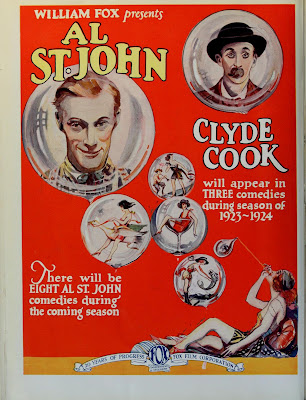"He was terrific. Some of the stunts he did are unbelievable. No special effects in silent movies, he is really up that high and falling that hard." Jerry Lewis
"I had the greatest sidekick in westerns. Better than Gabby Hayes, better than Smiley Burnette. Al's career dated back to the old Keystone studios, and he could still do amazing stunt work. He helped choreograph fight scenes, helped other actors with their falls, and during the breaks he would tell wonderful stories about the silent movie days." Buster Crabbe
 Born September 10, 1893, comedian, actor and acrobat Al St. John. He starred in dozens of comedy shorts with many studios and later on, as a supporting player in talkies, was the best of all the grizzled B-western sidekicks - after all, did you ever see Gabby Hayes dismount a horse and then do a backflip?
Born September 10, 1893, comedian, actor and acrobat Al St. John. He starred in dozens of comedy shorts with many studios and later on, as a supporting player in talkies, was the best of all the grizzled B-western sidekicks - after all, did you ever see Gabby Hayes dismount a horse and then do a backflip?
Al's unique ability to execute pure physical comedy with loose-limbed gusto, goofiness and hair-raising stuntman derring-do was only equaled by Al's Comique co-star Buster Keaton and England's triple-jointed king of the music halls, Lupino Lane.

Arguably, the acrobatic trifecta assembled for the Comique series - Roscoe Arbuckle, Buster Keaton and Al - was the greatest slapstick comedy lineup to ever work together onscreen.


Here's a 1914 Keystone Comedy co-starring Al with another great from the days of silent era slapstick, comedienne Alice Howell - the wacky redhead who preceded Lucille Ball by three decades, well known in silent comedy for her outrageous reactions and "Q-Tip" hairdo in Cinderella Cinders and other 1920's films.
It's a darn shame that, largely due to vault fires that claimed an incalculable chunk of film history, so many of Al's starring vehicles for Fox, Educational, Warner Brothers, Paramount and other studios remain rare and difficult to see.


Norwegian film researcher Annichen Skaren - who is writing a biography of Al - has done comedy fans and silent film buffs the favor of posting a fair amount of his surviving work on YouTube.
What's notable about Al, both in his slapstick comedy and later B-western incarnations, is how he repeatedly:
- Makes something out of nothing - A.K.A. low-budget be damned, let's do it!
- Brings out the unusual and surreal qualities out in any situation, no matter how humdrum. That skill was very likely taught to him by his talented uncle, Mack Sennett Studio star and writer-director Roscoe Arbuckle.


Case in point: the following early talkies Al starred in for Educational, Pathé and Paramount, respectively.
The Educational 1-reeler Western Knights was directed by Stephen Roberts - yes, indeedy, the same Stephen Roberts who directed the ultra-racy Miriam Hopkins vehicle The Story Of Temple Drake just a couple of years later.
In Two Fresh Eggs, clearly a Grade-Z production even in the low budget world of comedy shorts, Al is teamed with one of Vitagraph's principal silent era comedy stars, Jimmy Aubrey. It appears that the two comedians essentially shot some cheap wraparounds to support some even cheaper and unabashedly cheesy musical production numbers (presumably cutting room floor footage) from 1928-1929. Enjoy how Al, in this undistinguished 2-reeler, not only works harmoniously with the perpetually over-the-top Aubrey, but manages to totally steal the film in the process.
The comedy of Al St. John is also covered in the new book by film historian Anthony Balducci, Eighteen Comedians Of Silent Film and will be turning up from time to time in the TCM Mack Sennett retrospective this month.

Historian, author and comedy aficionado par excellence James L. Neibaur said it best: "Mack Sennett often made use of his many talents, from his ability to take amazing pratfalls to his prowess at playing any character. From large parts to small, Al St. John can be found as a strong protagonist, a frightened weakling, a romantic hero, a wily villain, a sneaky rival, or merely a slapstick presence in the background to bolster a scene. His wiry, limber body, his muscular strength, and his expressive facial manner were all perfect for the type of comics Sennett made the most use of, so Al worked regularly during his Keystone tenure. Al branched off as a solo artist, first at Paramount and then Warner Brothers before settling for a long period with Fox studios. What we can see from the existing examples is how Al continued to exhibit his versatility as a comic actor, how he continued to perform amazing stunts, and the impressive fact that he began exploring writing and directing, adding an auteurist approach to his work. Much of Al St. John's best work is among the maddeningly lost films of the silent screen, disallowing a full and complete assessment of his contribution to screen comedy."

And, until one can catch up on the TCM broadcasts via trusty DVR, here's Al in Dynamite Doggie and Out Of Place.
To the likes of Al, Buster Keaton, Roscoe Arbuckle and many more who quite literally risked their lives for the perfect sight gag, there aren't enough thanks. We're still laughing our you-know-whats off nearly a century later.



















































